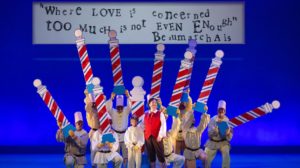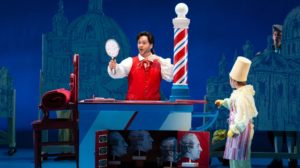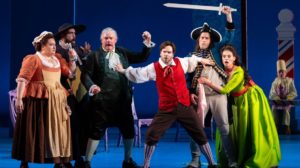Background Notes
In November 1815, Rossini was in Rome on one of his excused absences from the Neapolitan theaters to supervise a revival of Il turco in Italia and to write a new work, Torvaldo e Dorliska, for the Teatro Valle to open its Carnival season. He was approached by the rival Teatro Argentina with yet another commission. The new opera required all parties to work within a narrow timeframe – the Argentina was looking for a comic work to fill out its own winter season (the production had to be cast and ready by mid-February), and Rossini was expected back in Naples at any time. The contract was signed on December 15 with no specific subject in mind.
Jacopo Ferretti (later to be librettist for La Cenerentola) was initially selected to provide the text, but his product – a sentimental drama involving a typical love triangle – proved disappointing. Rossini turned to Cesare Sterbini, a librettist of less experience but one with whom he had just worked on Torvaldo. It is said to have been the composer’s brainchild to set Beaumarchais’ Le barbier de Séville, not a wholly original idea, as there were about six or seven treatments already on the market. This was not an uncommon thing to do – many operas of the 18th and 19th centuries were different musical settings of the same text, and the French playwright’s Barbier had already been set by two German composers of note, F. L. Benda and Johann André in 1776. Most notable of these, however, was Giovanni Paisiello’s Il barbiere di Siviglia, an exceedingly popular work from the 18th century that inspired Mozart to write his masterpiece on the playwright’s sequel, Le mariage de Figaro. Paisiello was still alive and somewhat of a curmudgeon when it came to his colleagues. So Rossini took an extra precaution, writing the venerated composer and explaining that his intention was not to best the older man’s cult favorite. Paisiello apparently had no objections, yet Sterbini and Rossini continued to play it safe by placing a “Notice to the Public” in their published libretto indicating their purpose was only to update Beaumarchais’ play to modern tastes. They even gave their opera a new title: Almaviva, ossia L’inutile precauzione (Almaviva or The Useless Precaution).

The collaborators probably fooled no one as each of their variants seemed for the better. Paisiello’s opera was cast in 18th-century courtly elegance, its music adhering to the Classical style, and its text revealing none of Beaumarchais’ sassy impertinence. Though Rossini still downplayed some of the political overtones, he consistently one-upped the old master with his inborn wit and exuberance. (Rossini, like Beaumarchais, seemed to have breathed a little of his own personality into the character of Figaro.) One excellent example is Don Basilio’s calumny aria, a perfect vehicle for the famous “Rossini crescendo” – slander first starts with a whisper, and with every repeated phrase adding greater instrumentation, eventually erupts like a thundering cannon. (The original play was truly inspirational, with the music master’s tirade laced with actual dynamic terminology). Rossini casts several of his numbers in the recently cultivated bel canto double aria – a slow section, often repeated and embellished to highlight the singer’s beautiful tone, followed by a fast-moving cabaletta, intended to show off great vocal agility and brilliant technique. In contrast, Bartolo’s Act ii arietta is fashioned in the style of Paisiello’s era, an obvious indicator of the foppish doctor’s advanced age. Rossini didn’t dare best Paisiello’s “sneezing trio” sung by Bartolo and his servants, the aged Giovinetta and the lazy Svegliato (to become Ambrogio and Bertha), but his enhancement of the brilliant quintet that follows Don Basilio’s unexpected arrival during the music lesson showed a temerarious challenge to his predecessor, as well as other distinguishing moments in the score. And, of course, Rossini’s ebullient orchestration and quick pace made a vast improvement on his Neapolitan counterpart’s otherwise serene and stodgy score, cautiously accented by occasional woodwind obbligato.
In accordance with the theatrical demands of the day, composition went swiftly. It was Rossini’s custom to settle into a city for a few days and get to know the singers before dashing off his score in a creative fervor, often in the most distracting environments (indeed, he found the rehearsal process to be the most arduous part of the process – back in the era of no stage directors, the composer and librettist bore that responsibility). The Argentina’s impresario, Duke Sforza-Cesarini, was beset with his own problems. He had inherited the theater from his ancestors and it continually lost money. There was no help from the papal government, which frowned upon theatrical entertainment, pronouncing Rome a “city of churches.” They did stipulate the Argentina was now to do comedy – formerly it was restricted to opera seria on a grand scale, with star singers and lavish sets – and this might have saved Sforza- Cesarini some money. Still, the poor duke, overwhelmed with stress, died of a stroke two weeks before the new opera’s premiere. All of these ills would bear down on the fateful opening night.
Rossini worked well under pressure, but a closer examination reveals many borrowed melodies from previous works (a common practice in the opera industry of the era), including all the storm music from La pietra del paragone and motives for Rosina’s first aria from Elisabetta, regina d’Inghilterra. The overture is another story. Apparently there had been an original work, based on Spanish folk songs, but it subsequently became detached from the autograph and disappeared. For later productions Rossini appropriated the overture from his recently produced Elisabetta, itself taken from Aureliano in Palmira. This is the popular orchestral work we know today.
The premiere of Il barbiere di Siviglia (as the work became known several months later, after Paisiello’s death) is one for the history books, yet no one knows for certain what really happened. There’s talk of open trapdoors and bloody noses, snarling cats and broken guitar strings, whistling and shouting (Roman audiences were not known for being docile theatergoers). It appears that the performance was disrupted by both supporters of Paisiello and those of the Teatro Valle who were upset over the infringement on its comic repertoire. Though dramatically more interesting, the late placement of Rosina’s “Una voce poco fa” didn’t help matters much, as audiences expected the prima donna to sing her entrance aria on her first appearance. At the end of the first act Rossini applauded his singers for their perseverance (barely a note had been heard), but the audience members took the gesture as one of conceit and a blatant disregard of their opinion. Act ii hardly went any better.
Not surprisingly, Rossini feigned illness for the second night (contractually he was to conduct the first three performances). With the rioters disbanded, the music could be heard and was immediately understood for the great masterpiece it would soon become. A surly mob surrounded Rossini’s hotel and demanded to see the maestro so they could show their great appreciation. When he refused to come out, things turned ugly as they began throwing food and smashing windows. Rossini was reported to have said “F**k them and their bravos and all the rest. I’m not coming out of here. I don’t know how poor García (the first Almaviva) phrased my refusal to that turbulent throng. In fact, he was hit in the eye by an orange, which gave him a black eye for several days. Meanwhile, the uproar in the street increased more and more.” (translation by Charles Osborne, The Bel Canto Operas, Amadeus Press, 1994)

Beaumarchais – the real figaro?
The curiously diverse career of Pierre-Augustin Caron de Beaumarchais (1732–1799) went far beyond that of the average playwright, a factotum-like existence that have led many to conclude he is the source of his own character, Figaro. Son of a watchmaker, he followed in the family tradition and his first notable achievement brought him to the attention of the king himself – a tiny escapement that vastly improved on the accuracy of time, an invention from which we benefit to this day. To his good fortune, Beaumarchais was also musical and, in addition to making watches for the king, he gave instructions to the royal daughters on the finer points of the harp.
Louis xv must have seen potential in the young Beaumarchais (who obtained his noble name by marrying a penniless widow). He was sent to Spain to negotiate a deal with Charles iii over the leasehold of Louisiana, which had passed into Spain’s hands as a result of the War of the Spanish Succession. Beaumarchais was unsuccessful in this pursuit, but still became the darling of Madrid. It was his first exposure to Spain, later the setting of his Figaro plays.
The budding playwright produced two early works, Eugenie in 1767 and Les deux amis in 1770, but things were about to go awry. As the result of some questionable business transactions, Beaumarchais found himself accused of forgery. After bungling a bribe to the court magistrate (a customary practice of the day), he received a sentence just short of the death penalty. The intervention of influential friends saved him from long-term imprisonment but not from the loss of his civil rights. The bitter experience empowered him to write his most popular works, Le barbier de Séville (1775) and the more politically subversive Le mariage de Figaro (completed in 1778). A final installment to the Figaro series, La mère coupable (1792), failed to achieve the tenor or success of its two predecessors, but has since inspired works from at least three composers: Darius Milhaud, Hiram Titus’s Rosina (produced by The Minnesota Opera in 1980) and John Corigliano’s The Ghosts of Versailles. Beaumarchais had planned for more sequels, but following the French Revolution, his role in the ancien régime was scrutinized by the new government. In 1794, while he was abroad, his family was placed under arrest and he himself designated a criminal émigré. He spent the subsequent years clearing his name.
During his legal troubles, the royal household remained strangely aloof. But with the ascension of the new king, Louis xvi, Beaumarchais found himself once again in its employ. He was instructed to covertly suppress some slanderous pamphlets concerning the royal family and was sent to England as a spy. Successful in these endeavors, the playwright was further engaged to arrange and supply arms to the New World in its struggle for American independence (France taking a special interest in discrediting its traditional foe, England). His efforts likely secured the victory at Saratoga, but the newly united democracy was short of cash, and Beaumarchais went to his grave unpaid. In 1835, his widow finally settled for a fraction of the debt and had to sail to America to get it.
Beaumarchais underwrote several other interesting entrepreneurial escapades including hot-air balloons (a marvel in France at the time) and a canal system that supplied water to Parisian homes. He also dabbled in opera – his Barbier was first submitted as an opéra comique, and he later engaged Mozart-rival Antonio Salieri to set his libretto for Tarare to music. Another musical adaptation, based on Voltaire’s Samson, remains unproduced.
As a play or an opera, Le barbier de Séville is the author’s most enduring success. The drama retains its life as a comedy of intrigue rather than a comedy of character in the tradition of Molière’s École des femmes. It is an ultimate work of reaction, with enough interest to still be on the playbill of the Comédie-Française even today. The self-portraying title character may bear the name of its creator, fils de Caron – son of Caron – but could also be derived from the original French and Figaro’s raison d’être, “faire la figue” – idiomatically speaking, to laugh at the world. In that humorous light, Beaumarchais’ wily barber is permitted the final moralizing maxim, the overriding theme to both genres: “When youth and love are in accord, working to foil an old man, even the very best he can do to stop them can only be called La précaution inutile, a futile precaution.”

commedia dell’arte
The Figaro plays are indebted not only to Beaumarchais’ eclectic lifetime activities but also to the theatrical tradition of commedia dell’arte. Of Italian origin, commedia dell’arte evolved during the 16th century from improvisatory scenes played at county fairs and marketplaces into a somewhat codified art form involving stock characters with predictable behavior and costume. Performances of commedia dell’arte were more frequent during Carnival, a time for anonymous celebration of the deadly sins, and these wanton acts made their way into commedia plots, giving it a rather ignoble, earthy quality. The use of masks (another practice derived from Carnival) further obscures the identity of the actual person, both reinforcing the character “type” and capturing mankind’s many faces. Like the Renaissance itself, the genre spread quickly across Europe. Brought to France by Catherine de’ Medici during the reign of her son, Charles ix, commedia dell’arte underwent a revival in 18th-century France and is found most famously in the works of Molière. In England, Shakespeare (whose sources were frequently Italian) would draw upon commedia plots and would sometimes introduce a “zanni” or nameless clown as a comic or sagacious figure (from which the word “zany” is derived).
Though only visual evidence remains (as the plots were never scripted), elements of commedia dell’arte can be found in nearly every one of Barber’s characters. The crafty valet, left as a foundling (but thinks he is the son of a noble), Truffaldino/Arlecchino easily translates into Figaro himself, a mixture of wit and ignorance but adept at slipping out of tricky situations. The nameless Lovers (sometimes identified as Lindoro and Isabella) transmute into the youthful infatuation between the count and Rosina. The characteristics of Il dottore and Pantalone are seen in Dr. Bartolo, the doddering, slightly stupid older man (though probably only middle-aged by Renaissance standards) in search of a young bride, a bit of a dolt, stingy and verbose. The slander-wielding, go-between Don Basilio is a conflation of several commedia characters’ darker side (the musical Brighella and Scapino in particular). Equally important is the pace of the production itself. The slapstick comedy of characters hiding behind chairs and inside closets, jumping out windows and receiving blows meant for others, and creating deception by use of disguise are all descended from the commedia dell’arte, particularly seen in the 18th century plays of Carlo Goldoni (also a librettist to many opera buffa) and Carlo Gozzi (later to inspire several 19th- and 20th-century operas).
Unable to survive the Age of Sensibility, the art form seems to have died in the written works of these two authors, yet commedia dell’arte remained of interest in the operatic world. Donizetti’s L’elisir d’amore features a potion-pushing charlatan in the character of Dr. Dulcamara as well as the braggart soldier Belcore (based on another commedia figure, Il capitano, the Spanish captain). Rossini drew upon the Italian comedy more than once, in the Turkish-abduction scenario outlined in L’italiana in Algeri (also utilized in Mozart’s The Abduction from the Seraglio) and La Cenerentola in the characters of the helpful servant Dandini and the pompous father Don Magnifico (another personage from the commedia). Leoncavallo’s Pagliacci tells the story of a commedia dell’arte troupe and includes an actual performance of a traditional skit, the cuckolded husband, and Carlo Collodi managed to include the same plot and characters in his Le avventure di Pinocchio (most recently realized by composer Jonathan Dove). In the 20th century, we find the harlequinade in Puccini’s Turandot (renamed Ping, Pang and Pong) and Richard Strauss’ Ariadne auf Naxos. These examples, familiar to The Minnesota Opera’s repertoire, are only a few from a larger body of commedia dell’arte-inspired works of the operatic genre.
Don’t miss out when Rossini’s irresistible rom-com The Barber of Seville, hits the Ordway stage for 6 performances, November 9-17. Get your tickets at mnopera.org/barber.